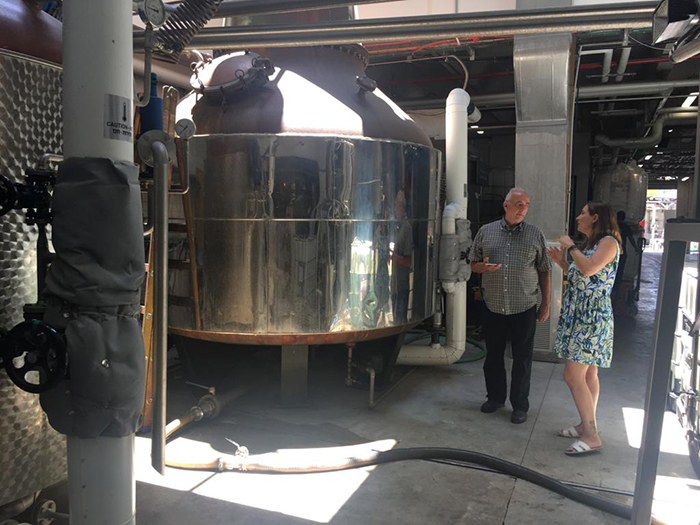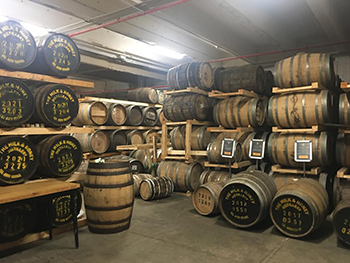
By Yoni Peres

JAFFA, Israel — As a child, I used to come almost every weekend here to Jaffa to watch my beloved soccer team Hapoel Tel Aviv play at Bloomfield Stadium, donated by the Bloomfield Canadian family. Recently, the stadium has undergone a thorough face lift, thanks to the generosity of the Bloomfield second generation, together with the city of Tel Aviv -Jaffa.
As an amateur musician, I have recently discovered the Tel Aviv-Yafo Music Center, adjacent to the Stadium, which, in addition to various activities, hosts the annual Jaffa Jazz festival, one of my favorite musical events.
And two days ago, I found out about the “Milk and Honey” Whisky distillery, located just across the street from the Stadium.
Israel’s first and only whisky distillery was established in 2015 by a group of ex high-tech Whisky fans. The main investor is Gal Kalkstein, currently the CEO. They rented an old building, formerly the famous “Eilat” bread bakery.
Among the leaders are Tal Chotiner, who is an experienced alcohol expert, bar owner, alcohol blogger, and sales and export director; Dana Baran, marketing director; Tomer Goren, a master distiller with experience in Scotland; and the late Dr James Swan- consultant, one of the world leading experts for warm climate distilling, who used to work with Chivas Regal, Jim Beam and other well-known distilleries. The staff includes more than 20 employees, and the visitor center hosts some 10,000 visitors a year, including workshops and lectures. The name comes from the “Land of Milk and Honey” and the logo is a combination of a dairy cow and honeybee.
Traditionally, whiskey has been aged in cold climate distilleries of the Western world, usually in chilly cellars, for periods of 10-15 years. The quality of the liquid was a factor of its age. However, over the last decade, warm-climate distilleries have become more and more popular, mainly in eastern Asia, New Zealand, and Australia. The advantage is that the process is much shorter- maturation in 4-5 years, saving the need of cooling the barrels. The drawback is the increase in “Angel Share” – yearly evaporation of 8-9 % in warm climate versus 1-2% in cold climate. These two methods are also referred to as “old world ” and “new world ” Whisky production.
The demand for Whisky has increased tremendously over the years and many new distilleries have been established to satisfy the growing consumption. Because of the tough competition, distilleries have been trying to “think outside of the box” – to have unique “terroir” of their products. For instance, most distilleries age their whisky in “ex Bourbon”, or “ex wine” barrels. “Milk and Honey” also uses “ex Pomegranate wine” barrels, which is unique in the world. Since the whisky is Kosher, they use “ex Israeli wine” barrels, with typical taste and aroma. Another example is aging in “ex Sherry ” barrels, imported from Jerez, Spain under Kosher supervision. Recently, some barrels were aged in the Dead Sea area, with a temperature range of 90 to 120 Fahrenheit, an aging time of one year, and Angel Share of 25%. Another advantage of Israel’s compact geography is the variety of climate and topographic zones – mountains, desert, low land, valleys.
The Visitor Center was established in 2016, selling Gin and Young Single Malt. In 2019, the first Whisky product, the “Classic” was launched, just before the Covid 19 outbreak. Several months later, the second series “Element” was launched. The newest series is the “Apex” including small batches of Ex Pomegranate wine and the Dead Sea edition. Another product is the “Gin Levantine,” with addition of local herbs and herbs.
Over 170,000 bottles are sold annually, to more than 25 countries over the world, including the Emirates and Gulf region. “Milk and Honey” has won industry awards, including the “Craft Distillery of the Year”.
The process begins with double osmosed water. Barley sprouts are imported from England and grinded to become malt. This is then cooked in the water. The liquid is separated from the malt, which is not discarded, but rather used for livestock feed. Yeast is added to the liquid for the fermentation process. The next stage after 48-72 hours of fermentation is the distilling from 6-7% alcohol, to 65-70%. Finally, the clear looking liquid, is poured into wooden barrels for the aging. The barrels are ex Bourbon, ex various wines, Sherry, Rum, Rye whiskey, Cognac, Israeli beers and even Tequila… The final Whisky product contains 46-47% alcohol.
Gal Kalkshtein, the founder and CEO, a high- tech entrepreneur, told me that he started with a micro- brewery at home. Later on he was introduced to Whisky lovers and decided to change from beer to Whisky.
“I did not expect such a rapid growth” said Gal. “We kept expanding the distillery as the demand increased. Whisky Advocate Magazine ranked our Classic series as one of the top 20 in the world”.
As the plant’s location is going up for sale to become one more skyscraper, Kalkshtein is looking for a new location. “Our goal is to reach annual sale of three million bottles,” he said.
The reason for name “Milk and Honey” he stated, was to attract potential Jews and Evangelists. “However, it was misinterpreted as Whisky with honey or milk flavor, not so appealing… ” So we decided to Change the name to M&H”….
Sampling some of their products was a pleasant experience. They tasted very good, especially the whisky aged in pomegranate barrels. I personally found some of the whiskys pretty strong, but adding some water to it helped.
*
Yoni Peres, a retired veterinarian, is a freelance writer and musician based in the greater Tel Aviv area.